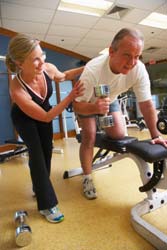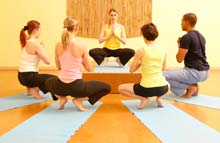8 Ways to Avoid The Top 5 Common Crippling Exercise Injuries
by www.SixWise.com
Regular workouts can help you prevent heart disease, stroke, diabetes and cancer. They promote healthy blood sugar levels, improve your mood and energy levels, help control your weight, promote healthy bone density and more.
|

Proper form is essential to preventing exercise injuries. If you’re not sure how to use a piece of equipment or perform an exercise, ask an expert to show you how.
|
In other words, there’s no shortage of benefits to hitting the gym or taking a brisk stroll or two around your block on a daily basis. That’s why experts recommend at least 30 minutes of moderate physical activity five or more days per week.
However, exercise, by its very nature, can also put you at risk of injury, especially if you’re new to working out or carrying excess weight. Even the most seasoned exercisers can find themselves with injuries from overuse of joints, accidental falls, or improper technique.
Exercise Injuries: How Common are They?
In 2008, close to 1,500 people visited U.S. emergency rooms due to injuries they received while using treadmills, weights, elliptical machines or other exercise equipment, a Consumer Products Safety Commission report found. However, they suggest that many exercise-related injuries are never reported, making the real number as high as 50,000.
Likewise, from 1990 to 2007, there were over 25,000 weight-training injuries seen in U.S. emergency rooms, according to a study in the American Journal of Sports Medicine, with sprains and strains the most common diagnosis. Most often, injuries occurred from weights dropping on the person.
Injuries occur even in more “gentle” exercise regimens, such as yoga. In 2006, there were 4,459 yoga-related injuries in the United States, a report by the U.S. Consumer Product Safety Commission found.
What are the Most Common Exercise Injuries?
The most common injuries related to yoga, according to the American Academy of Orthopaedic Surgeons (AAOS), are caused by repetitive strain to and overstretching of your neck, shoulders, spine, legs and knees.
Ironically, the very same things that provide your body the benefits during exercise -- the stretching, holding, moving, balancing and flexing -- can also lead to injury if you try to do too much, too quickly, or overuse the same muscle repeatedly.
While many exercise injuries are minor, they can be severe, leading to serious back or limb injury or requiring surgery. According to Kaiser Permanente, the most common exercise injuries are:
- Knee joint injuries: Sprains, torn cartilage, tendonitis and arthritis can all be exercise-related.
- Lower back injuries: Muscle tears, sprains and strains, ruptured discs, and stress fractures of the lower back are all possible.
- Shoulder rotator cuff injuries: Tears and swelling can occur in the muscles and tendons of the shoulder joint, especially after activities such as swimming or pitching.
- Hamstring muscle injuries: Tight hamstrings can easily be injured, especially while sprinting or jumping.
- Calf muscle injuries: Calf muscles can be torn or pulled during exercise, especially during sudden movements, such a quickly changing direction in a tennis game.
How to Protect Your Body From Exercise Injuries
The benefits of regular exercise far outweigh the risks of injury, but it’s still important to use safe and smart exercise habits to lower your injury risk. Fortunately, many exercise injuries are preventable by following these steps:
|

Your fitness program should include a variety of exercises, from cardio and strength-training to yoga. This will not only get your body in better shape, it will help protect your muscles and joints from repetitive or overuse injuries.
|
- Find a qualified trainer. Before you embark on an exercise program, invest in at least a few sessions with a personal trainer. He or she can teach you the proper intensity, technique and form to keep your workout both safe and effective.
- If you're a beginner, start out very slowly. You must begin your workouts gradually, or you risk burnout or injury. Begin by walking a mile or two, then gradually increase your pace and distance. After you feel your body beginning to shape up, you can start with other forms of higher intensity exercise.
- Warm up first. You should warm up by jogging in place, doing jumping jacks or other vigorous activity to warm up your muscles, tendons and ligaments. As Dr. Mehmet Oz said on DoctorOz.com:
“Before beginning any exercise, warm up your muscles for about 5 minutes to prevent injury. Remember, your muscles are like spaghetti strands, and they're pliable when they're warm (and more injury-prone if they're not). Jogging, brisk walking, cycling, or doing exercises with light or no weight will help prepare your muscles for activity.
One good rule: Do the same exercise you will be doing but at a slower pace or with lighter weight. Your goal is to move your joints through the same range of motion as they will do with exercise -- to raise your heart rate and to increase the temperature of your muscles (which will make them more viscous and less likely to be injured).”
- Stretch regularly. Stretching will help increase your flexibility, reduce muscle tension, improve your circulation and help prevent injuries if you do it on a regular basis. For an excellent stretching routine that takes just 15-20 minutes a day, check out the Stretching Toward a Healthier Life DVD.
Ideally, you should incorporate stretching into your workout right after your warm-up and again after your workout.
At this time, your muscles are warm and more elastic, and stretching increases your flexibility and maximizes the range of motion around your joints. You should stretch all the major muscles groups that you used during your workout.
What about stretching during your exercise routine? The rule of thumb is, if you feel tight go ahead and do a gentle stretch, then get back to your workout.
-
Be realistic. Getting into shape takes time, so don't expect to run a marathon after your first week of training. Be realistic about what to expect, and you'll begin to feel changes in your body and endurance within a few weeks. You also need to be realistic about how often you can exercise. It's probably not wise to go from zero exercise to a six-day per week exercise schedule. Try starting out with two or three days a week instead, and be sure to give your body time to recover between your workouts.
-
Wear appropriate clothing and gear. Tight, stiff clothing can restrict your movements, so if you need a wide range of motion, choose loose-fitting clothing. Likewise, if you’re a runner, invest in high-quality running shoes to help protect your feet and joints, or if you’re a mountain biker be sure you have the appropriate helmet and other protective gear on.
-
Listen to your body. If something feels too hard or painful, don't do it. If you're overly sore or short of breath, back off on the intensity. If you don't feel well one day, remember that it's OK to take a day off.
- Vary your workouts. One day try a beginner's kickboxing class at your gym. The next, go for a long, brisk walk with a friend. Then try a yoga class or weight lifting. Varying your workouts gives muscle groups time to recover and ensures they won’t become weak and prone to overuse injuries. It also ensures that you're working all of your muscle groups and getting all the benefits that exercise has to offer.
Get Fit and Healthy Without Injury
A fitness program that begins gradually and builds in intensity to challenge your muscle groups safely and effectively is best for preventing injury. Ideally, your workouts should be regular, not sporadic, so they condition your body for optimal performance.
In your journey toward this goal, we highly recommend delving into the awesome fitness program at MySheaNetics.com.
Most exercise programs are geared only to give you short term physical improvement. But SheaNetics understands the real goal for us all is to find total health and fulfillment that is life-lasting. This can only be achieved by creating harmony in body, mind and self. SheaNetics gives you the practical tools and everyday desire to make beneficial changes that are complete and permanent.
This at-home fitness program taught by fitness guru Shea Vaughn includes 3 core-building, mind-boosting, complete body-changing workouts along with 3 empowering original music CDs! They will guide you through, step-by-step, so you can avoid injury and experience life-lasting benefits.
In your quest for fitness, we highly recommend seeking out a personal trainer of your own, but if you don’t have the time or money to do so, this is the absolute next best thing! Check out SheaNetics from MySheaNetics.com … it’s an incredibly rewarding way to workout safely, avoid exercise injury and achieve the fitness goals you’re really after.
Recommended Reading
14 Things to do if You Feel Tired and Sore After Working Out
The Seven Most Dangerous Common Weight-Lifting Exercises and How to Do Them Properly
Sources
The American Journal of Sports Medicine April 2010 Vol. 38, No. 4, 765-771
USAToday.com February 22, 2010
Kaiser Permanente
The American Academy of Orthpaedic Surgeons
DoctorOz.com